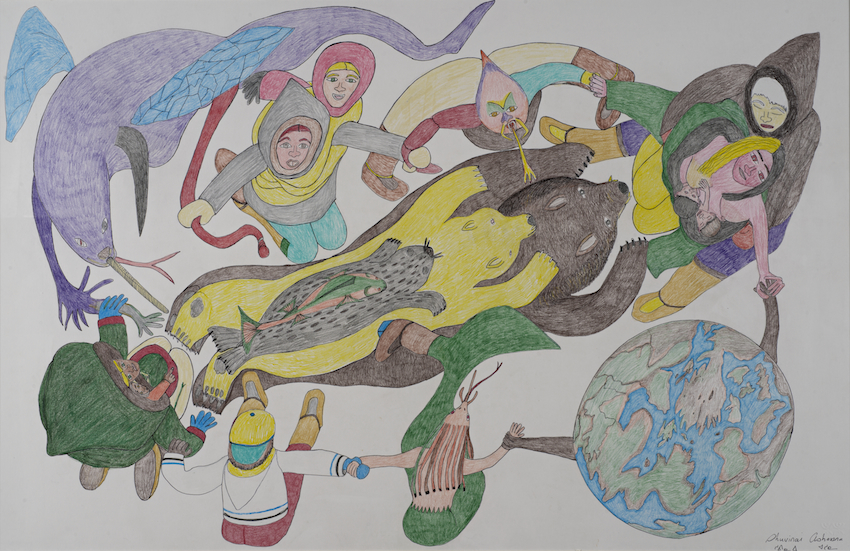
Shuvinai Ashoona (Inuit, Cape Dorset, Canada, b. 1961)
Composition (People, Animals, and the World Holding Hands), 2007–8
Ink, pencil, and crayon
26.25 x 40 inches
Reproduced with the permissions of Dorset Fine Arts
“When I start to draw I remember things that I have experienced or seen… Sometimes they come out more realistically but sometimes they turn out completely different.”
— Shuvinai Ashoona
At first glance, one might be tempted to erroneously attribute the depicted circle of harmony among the assembled creatures to a story from Inuit mythology. However, this vivacious and stunningly colorful drawing demonstrates Shuvinai Ashoona’s personal creativity and dark imagination more so than conforming to outside expectations of Inuit art. Ashoona is known in the art world for her detail-oriented and dream-like drawing style. Ashoona credits television shows, as well as her memories, as sources of inspiration for her works. Although many of her representational drawings of tents and natural landscapes evoke Inuit community and history, much of her art is comprised of surrealistic, fantastical images that flow from her imagination onto the canvas.
Shuvinai Ashoona’s self-taught drawing style has been declared by family members and fellow artists to be unlike anything they have ever seen. She describes her artistic process as letting the pencil take control and is often surprised at what images emerge. Her immediate family includes several gifted and well-known artists who tried on multiple occasions to welcome her into their group. Although she retains close familial bonds with them, Ashoona prefers to work on her art privately, away from other people. Her ideal setting when drawing is in her room, only accompanied by a black felt-tip pen and paper. Quite different from the art cooperative experience, this social isolation has allowed her to develop a remarkably original drawing style that conveys her novel way of seeing the world. This theme of isolation can, surprisingly, also be seen in the circle in this drawing.
The anthropomorphic world in this composition is physically distanced and separated from the rest of close-knit circle of harmony and kinship, where different beings grasp, touch, and overlap with each other. This drawing is representative of the recent theme in Ashoona’s works: entire worlds, endowed with vitality, sprouting heads, arms, and other limbs. The worlds in her drawings can be interpreted as her response to contemporary political and environmental issues. As seen in this gallery, her harpooned worlds replace dying sea animals as symbols for dwindling natural resources. The world in this drawing holds hands with an assortment of people, dressed in winter clothing, and half-human, half-monster hybrids. The beings form an oval that fills the page to the brim and is itself filled almost completely with the figures of four animals. However, Ashoona’s depiction of the world floats in the lower right corner, immersed in blank space.
Although at first glance the drawing appears to depict harmony in nature among all living things, the unsmiling faces of the beings, as well as the strangeness of the situation as a whole, unsettle the viewer. Ashoona’s sinuous lines and soft colors relax and draw the viewer into the scene. However, the inconsistent coloring of the figures unexpectedly allows viewers to see individual coloring strokes and the hand of the artist in the creation of this work. It also adds an ephemeral quality to the work, as if the ring of figures could vanish at any moment.
Lastly, in the very midst of this apparent harmony is ambiguity. The four animals surrounded by the main circle may have sacrificed their lives. The disturbing nature of her drawings, as demonstrated in this work, has become a central component of her style. However, this strangeness often coexists with lighthearted wonder, as seen in this somewhat whimsical drawing. This composition is a prime example of Ashoona’s resistance to surrendering to the traditional expectations and demands of the Western art markets, choosing instead to envision her own unique and culturally specific world of Inuit art.
Leighton Suen ’14 & Logan Woodruff ’14
